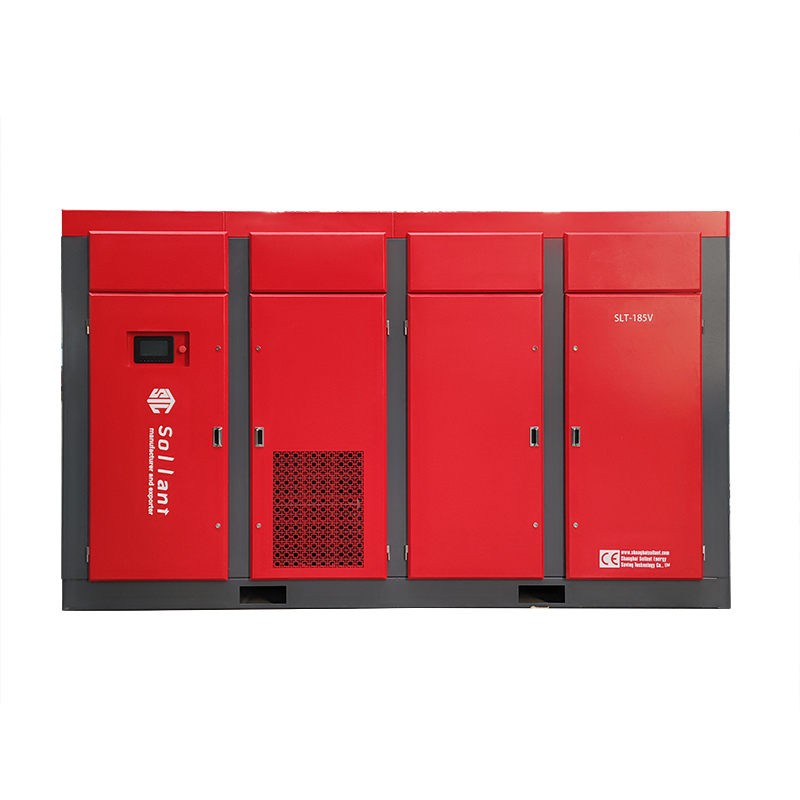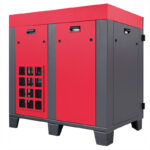Introduction
Screw air compressors are widely used in various industries due to their high efficiency, reliability, and low operating costs. This article provides a comprehensive analysis of their working principles, oil and gas flow, key components, and future development trends.
1. Overview of Screw Air Compressors
Screw air compressors are positive displacement compressors that rely on the rotation of intermeshing spiral rotors (male and female) to compress gas. Their key advantages include:
- High efficiency & reliability – Continuous, pulsation-free air supply with stable flow rates.
- Compact design – High-speed operation, small size, and lightweight.
- Durability – Fewer moving parts, less wear, and low maintenance costs.
- Resistance to liquid shock – Handles wet compression effectively.
- Low operating costs – High volumetric efficiency with minimal power consumption.
- Automation-ready – Supports unattended operation.
- Low noise & vibration – Suitable for various working environments.
- Versatile applications – Compresses different gases (air, natural gas, inert gases) across a broad pressure range.
2. Working Principle of Screw Air Compressors
The operation of screw air compressors follows three primary stages: Intake, Compression, and Exhaust.
(I) Intake Process
- Rotor Rotation – The motor drives the male rotor, which in turn rotates the female rotor. The spiral grooves continuously create new compression spaces.
- Gas Entry – The pressure difference between the inlet and internal chamber allows gas to be drawn into the spaces between the rotors. As the rotors turn, the volume increases until it reaches its maximum capacity.
(II) Compression Process
- Volume Reduction – As the rotors continue rotating, the trapped air volume decreases, increasing pressure and temperature.
- Oil Injection Cooling (for Oil-Injected Models) – Lubricating oil is injected into the compression chamber, serving multiple functions:
- Cooling – Reduces gas temperature.
- Sealing – Improves volumetric efficiency.
- Lubrication – Reduces wear on moving parts.
- Noise Reduction – Dampens vibrations and operational noise.
- Oil Regulation – The oil pressure regulating valve controls oil injection, ensuring optimal performance.
(III) Exhaust Process
- Gas Discharge – Compressed air exits when chamber pressure surpasses exhaust pipe pressure.
- Oil Separation (for Oil-Injected Models) – The discharged oil-gas mixture enters an oil-gas separator, which filters out lubricating oil for recycling, while purified air moves to post-processing.
3. Oil and Gas Flow in Screw Air Compressors
(I) Oil Circuit Flow
- Lubricating Oil Circulation – Extracted from the oil tank, the oil is filtered before entering the compressor. Functions include:
- Cooling – Absorbs heat from compression.
- Sealing – Reduces air leakage and improves efficiency.
- Lubrication – Minimizes wear on rotors and bearings.
- Noise Reduction – Dampens mechanical vibrations.
- Oil Cooling – Hot oil is cooled via air-cooled or water-cooled oil coolers before re-entering circulation.
- Oil Filtration – Oil filters remove contaminants, with some models featuring additional online separation filters.
(II) Gas Flow
- Compression Stage – Gas pressure and temperature rise during compression.
- Oil-Gas Separation – Separated in two phases:
- Primary Separation – Centrifugal force removes most oil.
- Fine Separation – Oil-gas filter elements capture remaining oil mist.
- Post-Processing (Optional)
- Drying – Adsorption or refrigeration dryers reduce moisture content.
- Filtration – Removes solid particles, moisture, and oil mist.
- Deodorization – Activated carbon filters eliminate odors.
- Final Air Supply – The purified compressed air is delivered to the user.
4. Key Components of a Screw Air Compressor
- Rotors – The core components determining airflow and pressure.
- Synchronous Gears – Ensure precise rotor meshing.
- Bearings – Support rotor movement and withstand loads.
- Oil Filter – Removes contaminants from lubricating oil.
- Oil Cooler – Regulates oil temperature for efficiency.
- Oil-Gas Separator – Separates lubricating oil from compressed air.
- Oil Pressure Regulating Valve – Controls oil injection levels.
- Intake Valve – Adjusts air intake for flow regulation.
- Exhaust Valve – Manages compressed air release.
5. Future Trends in Screw Air Compressor Technology
- Energy Efficiency
- Advanced rotor designs for improved volumetric efficiency.
- Variable frequency drives (VFD) for precise flow control.
- Optimized lubrication systems to enhance oil utilization.
- Smart & Connected Solutions
- IoT-based remote monitoring and predictive maintenance.
- Intelligent control systems for automated operations.
- Eco-Friendly Designs
- Development of environmentally safe lubricants.
- Enhanced oil-gas separation to reduce emissions.
- Modular & Scalable Systems
- Flexible designs allowing easy expansion and upgrades.
- Noise Reduction
- Structural enhancements and noise-dampening technologies.
Conclusion
Screw air compressors remain the backbone of industrial pneumatic systems. Understanding their working principles, oil and gas processes, and key components helps optimize their use. With ongoing advancements, these compressors continue to evolve toward higher efficiency, automation, and environmental sustainability, providing reliable compressed air solutions across industries.
Sollant Signs Agreement with Spanish Distributor to Expand into the European Market!





